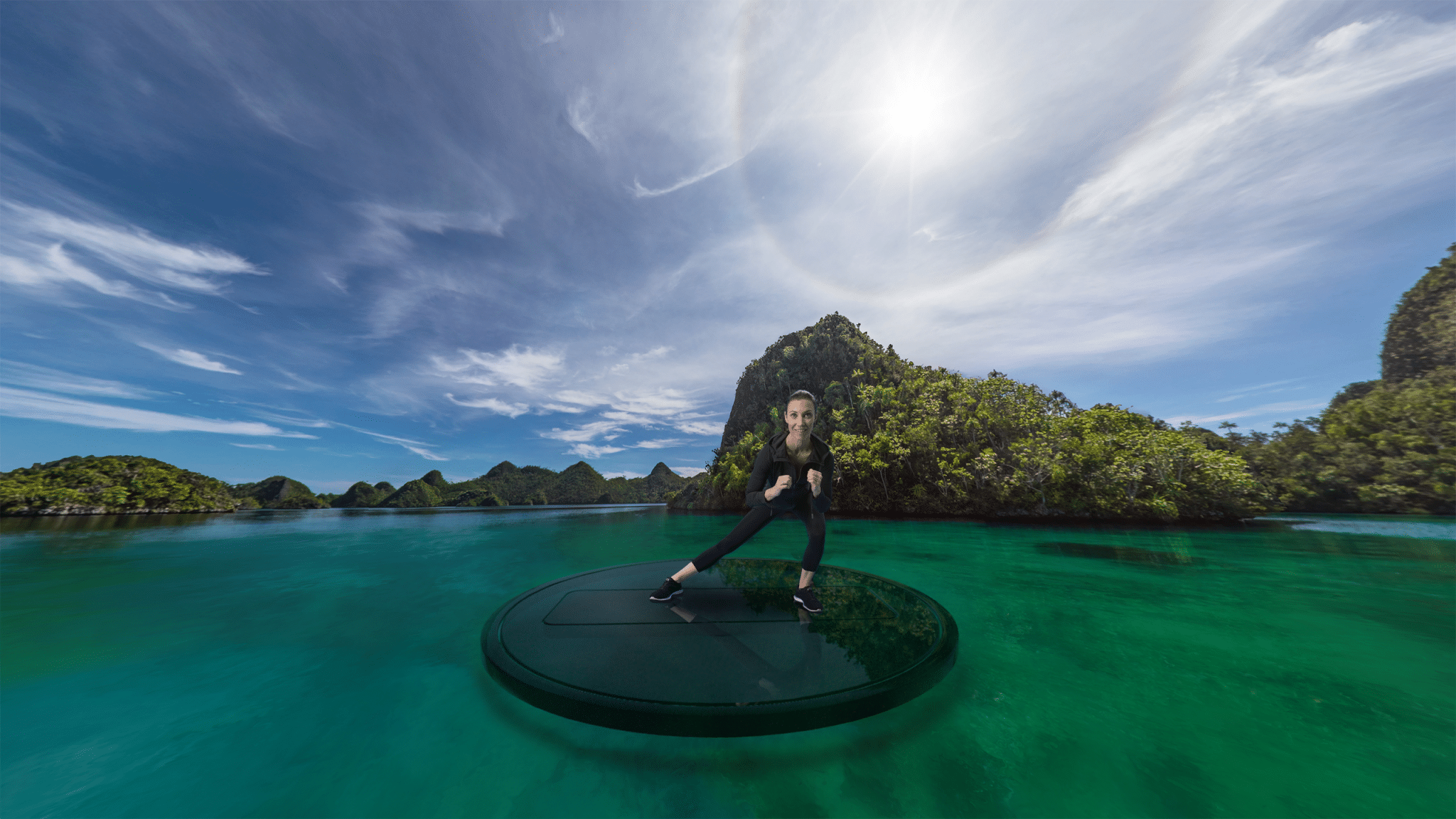It’s been over two weeks since Within launched Supernatural, its radical new VR subscription service on Oculus Quest. It’s a $20-a-month app that wants to swap the treadmill for a videogame. After extensive testing, we can now weigh in on the big question: is Supernatural worth it?
Update: Since publishing this article, Within has revealed a new, limited-time offer for Supernatural to get the first year for $149, effectively making it $13 a month. The deal is available until May 31. Original story continues below.
In the video below, three of the UploadVR team headed into our virtual studio to discuss the pros and cons of Supernatural based on a few weeks of use. We found some common ground on both sides. On the one hand, there’s the app’s strong tracklist of music with great mapping to maximize spending your energy. But the question of its price, especially in the face of competition, is a tough one. Read on for more info about the app and our thoughts on if Supernatural is worth it.
Before we go any further, I have to point out that it is very easy for you to make your mind up about Supernatural yourself. Within offers an entire month free — a generous offer considering the hefty monthly subscription — and if you have any interest in VR fitness at all, you really should take the company up on it.
It’s also important to note that we’re assessing the service just as its starting out and that there is, hopefully, a long runway of tweaks, additions and improvements to be made to the service. With that in mind, let’s dive in.
What Is Supernatural?
Make no mistake about it, Supernatural is a Beat Saber clone. Its core mechanics have you swinging two colored bats to corresponding notes that fly towards you in time with a music track. Occasionally, triangular-shaped obstacles force you to squat, too.
But, rather than simply picking from a list of songs to master with repeat playthroughs, Supernatural offers a new workout routine (or playlist) every 24 hours. Workouts between 10 – 30 minutes are accompanied with introductions from fitness coaches that will then spur you on as you play. A companion app will track your progress, too.
What Kind Of A Workout Does It Offer?
Supernatural aims to wear you down with a mix of consistent arm swinging and squatting from side-to-side for a workout that uses both upper and lower body. Though it’s technically easy to get away with casual movements, trainers encourage you to swing with power and from the core to maximize your workout.
If you’re doing particularly well, the app’s adaptive difficulty with pick up the pace, or slow it down if you’re struggling. The aim is to create an experience where you’re not focused on scores so much as flow and pace, though you can also choose between high and low intensities and a Pro workout that offers the most intense mapping right the way through.
How Intense Is It?
Fairly obviously, the answer to this question will depend on a lot on your own physical fitness. For our own testing, three of the UploadVR staff tried Supernatural for a few weeks. Myself, Video Editor Zeena Al-Obaidi, and Senior Editor David Jagneaux all took part.
I came to Supernatural already as someone that has exercised every day for the past few months, alternating between 5K runs and an assortment of home-based workouts. Personally, what I’ve found is an experience I can approach enthusiastically at the end of one of my other workouts as a means of keeping active for a bit longer, if not something that has often left me entirely exhausted, especially after my legs acclimatized to VR’s most demanding squats. I wouldn’t count a lone Supernatural session as a sufficient day’s workout myself.
Video Editor Zeena Al-Obaidi, however, attempted to swap out a daily routine of 20 – 30 minute YouTube-guided high-intensity training workouts with the app and quickly found herself eager to switch back as Supernatural wasn’t providing the same level of exhaustion. Meanwhile, Senior Editor David Jagneaux approached Supernatural as a fresh start for exercise after injuring his knee during intense personal training last year. He loved his initial workout but has subsequently found it to be less and less demanding as he acclimatized to it.
That said, we all agreed that by VR’s standards, Supernatural offers one of the most intense and dedicated workouts you can find inside a headset. It just doesn’t really compare to what’s available in the outside world.
How Much Fun Is It?
Obviously, there’s not much point investing in a gamified fitness program if the game itself isn’t any fun. Fortunately, by sticking close to the Beat Saber formula, Supernatural has an engaging and addictive set of mechanics right at its core that lots — if not all — VR players will enjoy.
In Supernatural’s best songs, it’s pure magic, a thrilling rollercoaster with a seamless flow that pulls you along for the ride. Adaptive difficulty keeps the pace going and the lively, energetic tracklist never feels out of place or weak. Of course, I say ‘not all’ because, even as VR’s most successful game, Beat Saber isn’t for everyone. If you’re looking for a fitness game perhaps with more escapism, this isn’t the one for you.
But there are more troubling aspects, too. While song mapping is on-point and active, I’ve personally really struggled with matching the right color to the corresponding note in more complex moments. In Beat Saber, this is one of many intricacies that makes it such an engaging game. When I approach Supernatural, I am in the mindset of getting fit, hitting goals and making progress, not trying to mentally navigate a maze. Every time my brain pulls a fast one on me, I feel discouraged. And yes, within time I might improve and fitness instructors try to reassure you it’s not always about the accuracy, but taking a hit to workout morale — one based on mental dexterity rather than my actual health — that early on is hugely concerning.
How Does It Track Activity?
Though you’ll get stats on accuracy and power of swings at the end of every song for more detailed statistics you’ll need a smartwatch and a companion app. Other VR apps have in-game calorie counters, though it’s important to point out that there’s very little way of telling how accurate these are. Still, even rough approximations can be useful to spur you on and give you something useful to measure, especially if you don’t have access to a smartwatch.
How Does It Compare To Beat Saber And Other VR Fitness Apps?
Although the service is nearly identical to Beat Saber in terms of mechanics, rest assured this is a premium imitation. Supernatural’s sleek black and white design and real-world environments are a welcome breath of fresh air from the numerous neon imitators that have followed in the wake of Saber (or, going back further, Audioshield). Its tracklist is equally top tier, boasting the likes of Lady Gaga and Kendrick Lamar. Most importantly, though, its daily supply of new workout routines, each individually coached by one of a handful of personal trainers, gives you a new combination of tracks to try every 24 hours at different intensities, even if some tracks will repeat over the course of a few weeks.
Beat Saber isn’t the only VR fitness app, though. Odders Lab’s OhShape, for example, has you lunging and ducking to win human Tetris and BoxVR’s punching workouts might play a little rickety, but it’s not short on curated playlists and offers multiplayer support. Supernatural’s premium feel still bests its competitors, but I personally also find OhShape’s mix of shape-throwing, coin-grabbing, wall-dodging gameplay to offer a more dynamic mix of work.
How Does It Compare To Non-VR Fitness Options?
There’s really two options to consider here: traditional workout options like gym subscriptions or home exercise or, perhaps more appropriate, subscriptions to digital fitness services accessed on your phone or PC.
Compared to a gym or out-of-home exercise, Supernatural has the obvious advantage of not making you leave the house. However, if you’ve proven to yourself that getting to the gym on a regular basis isn’t an obstacle before, the benefits really stop there. Supernatural just doesn’t offer the variety of intensity of exercise that you’d get from weight lifting, more dedicated cardio or class-based or personal training sessions. With proper motivation, you could even get more mileage out of household equipment like weights or treadmills.
Plus, as someone who has subscribed to professional at-home fitness plans before, I don’t think Supernatural offers the intensity or diversity they do for a similar price, either. Dedicated workout plans are, from my experience, unquestionably the better way to go. But it’s also true that these sorts of plans take an enormous amount of self-motivation and persistence.
And that’s the key; all the gym equipment in the world doesn’t matter if you can’t bring yourself to use it. What Supernatural may lack in intensity, it makes up for in this department. Through its brand of enjoyable exercise, Supernatural doesn’t feel nearly as much of a chore to return to time-after-time. But, as someone that doesn’t struggle to gather motivation to workout, this is less of a factor for me. You might need to ask yourself about your own self-discipline when deciding if the app is worth it.
Is Supernatural Worth $20 A Month?
That’s the big, expensive elephant in the room. I do believe that for a certain set of people that struggle with routine, mundane exercise and need more motivation for a VR workout than repeating Beat Saber songs, Supernatural’s combination of enjoyable gameplay and persistent structure could be hugely beneficial.
Personally, I find it hard to justify spending $20 a month on Supernatural when it is so single-mindedly obsessed with Beat Saber. A year of subscription will cost you an astounding $240. As of right now, the entire Beat Saber experience, including the base game, all the free updates and premium DLC (released over the course of the past few years), would set you back $111.58 on Steam. That’s a significant all-in difference and, crucially, if you’re serious about VR fitness you could then pile on some other games for variety.
You might argue that comparing the subscription fee to that of a Netflix or online gaming account is unfair; if you were to instead compare it to traditional digital workout subscriptions it stacks up quite well. But Supernatural doesn’t do enough to separate itself from one-time purchase VR games to warrant that $20 price tag and, even if it did, it doesn’t offer the variety and versatility you’ll find in many of the top programs, in my opinion.
Conclusion
When deciding if Supernatural is worth it for you, you need to ask yourself a set of questions. Firstly, are you sure that more traditional forms of exercise won’t work for you? And, if they wouldn’t, would your money be better spent instead completing a library of Beat Saber songs and other VR fitness games you’ll be able to play forever with a one-time purchase? If you seriously consider both of those points and decide it’s still worth it, Supernatural could make genuinely great progress in your life. But I suspect that the number of people that truly fit that criteria is worryingly small for a service as ambitious as this.
VR fitness is a great thing, a wonderfully unexpected side-effect of regular use of an entertainment product. In Supernatural, you can see a well-intentioned, thoughtfully-planned attempt to capitalize on that positivity. And for some people I don’t doubt adhering to a few months of daily workouts inside the app could make a dramatic change. But I suspect for a great many more people certain elements like price and variety need to go back to the drawing board if they’re to represent anything like the right kind of value. At its core, pushing through the workout wall is genuinely enjoyable in Supernatural but its hefty monthly subscription may be one mountain too tough to climb.
—
Supernatural is available now on the Oculus Quest, but available in the US and Canada only.



























